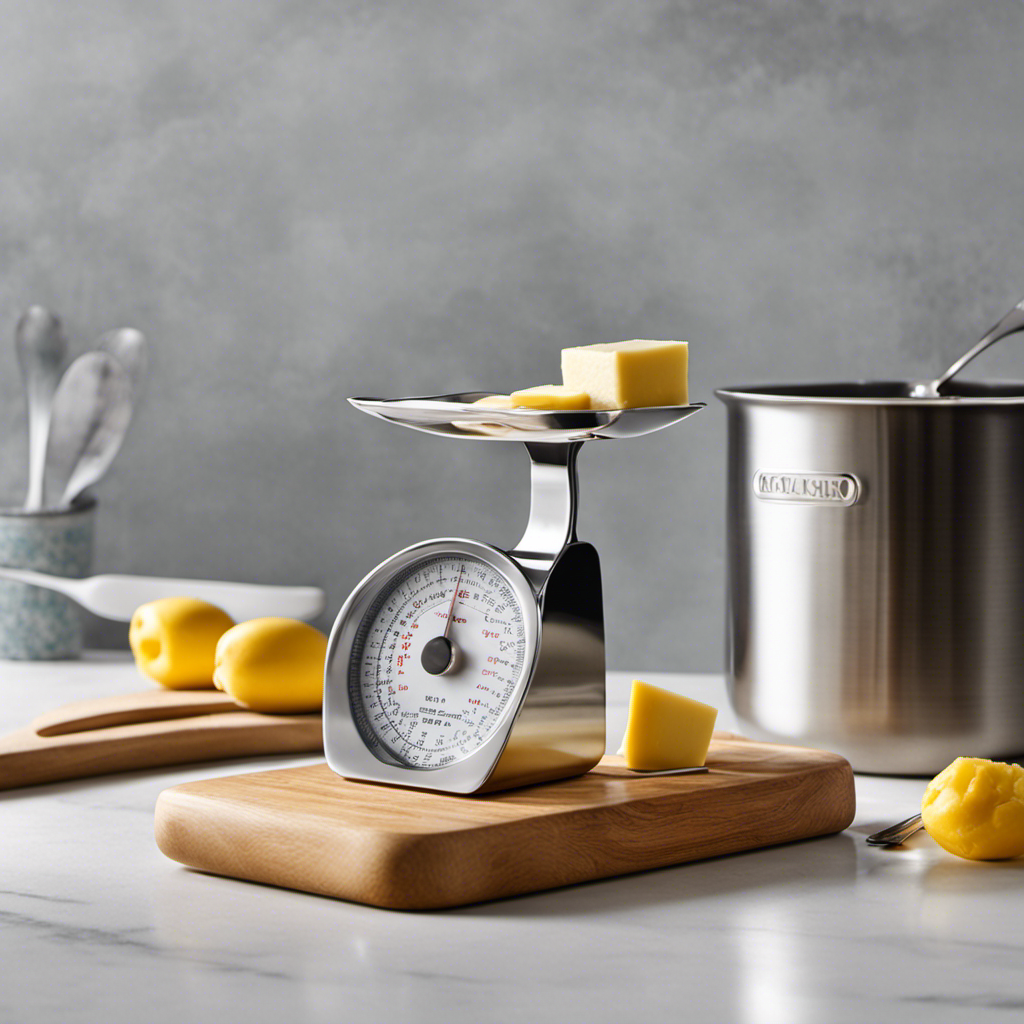I’ve always been curious about the quantity of cream required to produce a pound of butter. The art of making butter is intriguing, and grasping the scientific principles behind it can assist in attaining the ideal consistency.
In this article, we will dive into the butter to cream ratio, calculate the amount of cream needed, and explore factors that affect the yield of butter.
So, grab your apron and let’s uncover the secrets of making homemade butter!
Key Takeaways
- The optimal cream-to-butter ratio is crucial for achieving the desired consistency and texture of butter.
- Adjusting ratios of cream to butter can enhance the flavor profile of the butter.
- Different factors such as fat content, churning speed, and temperature can affect the consistency of butter.
- The general rule of thumb is that it takes about 2 cups of cream to make 1 pound of butter, but ratios can be adjusted based on desired richness and fat content.
The Science Behind Butter Making
The science behind butter making is fascinating because it involves the separation of milk fat from cream. To understand this process, it is essential to comprehend churners and conduct butterfat content analysis.
Churners are devices that agitate cream, causing the fat globules to coalesce and form butter. Different types of churners, such as paddle churns or barrel churns, can affect the final texture and flavor of the butter.
Butterfat content analysis is crucial to determine the quality and richness of the cream. This analysis involves measuring the percentage of fat in the cream, which directly affects the yield of butter.
Understanding the Butter to Cream Ratio
When it comes to butter making, understanding the optimal cream-to-butter ratio is crucial. This ratio determines the amount of cream needed to produce a pound of butter, ensuring the desired consistency and texture.
However, several factors can affect butter consistency, such as the fat content of the cream, churning speed, and temperature. By adjusting the cream-to-butter ratio, one can also enhance the flavor profile of the butter, allowing for customization to suit different tastes and preferences.
Optimal Cream-To-Butter Ratio
To make a pound of butter, you’ll want to use a specific cream-to-butter ratio. The optimal ratio depends on various factors, such as cream composition and butter production techniques. It is important to understand that the cream composition can vary depending on factors such as breed of cow, diet, and processing methods. However, a general guideline for the cream-to-butter ratio is approximately 4 parts cream to 1 part butter. This ratio ensures that the butter has the right balance of moisture and fat content for a smooth and creamy texture.
| Cream (parts) | Butter (parts) |
|---|---|
| 4 | 1 |
| 6 | 1.5 |
| 8 | 2 |
Using a higher cream-to-butter ratio will result in a softer and more spreadable butter, while a lower ratio will yield a firmer and more concentrated flavor. Experimenting with different ratios can help you find the perfect balance that suits your taste preferences and desired consistency.
Factors Affecting Butter Consistency
Factors like cream composition, processing methods, and breed of cow can affect the consistency of butter.
Cream composition plays a crucial role in determining the final texture of butter. The fat content in cream should ideally be around 30-36% for optimal results. Additionally, the quality of cream used is essential. Cream that is fresh, free from impurities, and low in acidity will result in better consistency.
The processing methods employed also impact the final product. For instance, adjusting the churn speed can influence the butter’s texture.
Moreover, the breed of the cow can affect the composition of the milk, which in turn affects the butter consistency.
Thus, it is important to consider these factors when aiming for a desired butter consistency.
Adjusting Ratios for Flavor
You can adjust the ratios of ingredients to enhance the flavor of your butter. Experimenting with ratios allows you to customize the taste according to your preferences.
To achieve a stronger flavor, you can increase the amount of salt or add additional seasonings such as herbs or spices. On the other hand, if you prefer a milder taste, reducing the amount of salt or omitting certain ingredients can help achieve that.
It’s important to note that adjusting flavors is a matter of personal preference, so it’s recommended to start with small increments and taste as you go to find the perfect balance.
Calculating the Amount of Cream Needed
When determining the amount of cream needed to make butter, it is crucial to understand the cream-to-butter ratio. This ratio refers to the amount of cream required to produce a specific quantity of butter, usually measured in pounds.
To calculate the cream quantity accurately, one must consider factors such as the desired yield and the water content of the cream. By understanding these key points, one can ensure precise measurements and successful butter production.
Cream-To-Butter Ratio
To determine the cream-to-butter ratio, simply mix together one pint of heavy cream and a pinch of salt. Adjusting the ratios for flavor and calculating the cream quantity can be a bit tricky. Here are some tips to help you out:
-
Consider the desired richness: If you prefer a richer butter, increase the amount of cream used. For a lighter butter, decrease the cream quantity.
-
Take into account the fat content: Different cream varieties have different fat percentages. Adjust the ratio based on the fat content of the cream you’re using.
-
Experiment with salt levels: Adding a pinch of salt enhances the flavor of the butter. However, you can adjust the amount according to your taste preferences.
By following these guidelines, you can easily determine the perfect cream-to-butter ratio for your desired outcome.
Happy butter making!
Determining Cream Quantity
If you want a lighter butter, decreasing the amount of cream used is the key. Adjusting the flavor of butter can be done by adjusting the cream-to-butter ratio. To calculate the quantity of cream needed to make a pound of butter, you can use the following formula:
Cream Quantity (in cups) = Butter Quantity (in pounds) * Cream-to-Butter RatioHere is an example table showing the cream quantities needed to make different amounts of butter:
| Butter Quantity (lbs) | Cream-to-Butter Ratio | Cream Quantity (cups) |
|---|---|---|
| 1 | 2:1 | 2 |
| 2 | 3:1 | 6 |
| 3 | 4:1 | 12 |
| 4 | 5:1 | 20 |
| 5 | 6:1 | 30 |
Factors Affecting the Yield of Butter
You can increase the yield of butter by using cream with a higher fat content. When it comes to the butter making process, there are various factors that can affect the final outcome. Here are some key points to consider:
- Cream Separation Techniques:
- Centrifugation: This method uses high-speed spinning to separate the cream from the milk.
- Gravity Separation: Allowing the cream to naturally rise to the top due to its lower density.
- Skimming: Removing the cream layer manually from the top of the milk.
These separation techniques are crucial in obtaining high-quality cream for butter making. The fat content of the cream plays a significant role in determining the yield of butter. Cream with a higher fat content will result in a greater amount of butter produced. Therefore, selecting cream with a higher fat content is essential for maximizing the yield during the butter making process.
Achieving the Perfect Texture of Butter
When it comes to achieving the perfect texture of butter, two key factors to consider are the cream to butter ratios and the techniques for smoothness.
The cream to butter ratios determine how much butter you can yield from a given amount of cream, and finding the right ratio is crucial for achieving the desired texture.
Employing various techniques for smoothness, such as churning at the optimal temperature and incorporating air into the butter, can help create a butter that is smooth and spreadable.
Cream to Butter Ratios
The cream to butter ratio will determine how much butter you can make. Adjusting ratios for taste and achieving the desired texture is crucial when making butter.
Here are some important points to consider:
-
Cream quantity calculations: To determine how much cream you need, take into account the desired amount of butter you want to yield. A general rule of thumb is that it takes about 2 cups of cream to make 1 pound of butter.
-
Adjusting ratios for taste: Different ratios of cream to butter can result in variations in taste. If you prefer a richer and creamier butter, increase the amount of cream used. On the other hand, if you prefer a more concentrated butter flavor, decrease the cream and increase the butterfat content.
Techniques for Smoothness
For a smoother texture, it’s important to ensure that the cream is properly chilled before churning it into butter. This is because colder cream solidifies more efficiently, resulting in a smoother and creamier butter. To achieve this, I recommend placing the cream in the refrigerator for at least 12 hours before churning.
Additionally, adjusting the ratios of cream to butter can also affect the texture. If you prefer a softer and more spreadable butter, you can increase the amount of cream used. On the other hand, if you prefer a firmer butter, you can reduce the amount of cream. Experimenting with different ratios will allow you to find the perfect balance for your taste preferences.
Lastly, using proper churning techniques, such as maintaining a constant speed and scraping down the sides of the churn, can help achieve a smooth and velvety texture.
Tips for Choosing the Right Cream
To choose the right cream, you should consider its fat content and freshness. Adjusting cream ratios is crucial in achieving the desired consistency and flavor of butter. Here are some cream quality considerations:
-
Fat content: Look for cream with a high fat content, ideally above 35%. This ensures a richer and creamier butter.
-
Freshness: Choose cream that is fresh and hasn’t expired. Fresh cream produces better-tasting butter.
When selecting cream, it’s important to understand that the quality of the cream will directly impact the quality of the butter you produce. By considering the fat content and freshness of the cream, you can ensure optimal results and a delicious end product.
Now that we’ve covered the tips for choosing the right cream, let’s delve into the different methods of churning butter.
Different Methods of Churning Butter
Now that we’ve covered how to choose the right cream, let’s explore various methods of churning butter. Churning butter is the process of separating the milk solids from the cream to create butter. There are several different churning techniques that can be used, each resulting in a slightly different texture and flavor. The most common method is using a churn, which involves agitating the cream until the butter separates. Another technique is the jar method, where the cream is placed in a jar and shaken vigorously until butter forms. Troubleshooting butter making problems can be quite frustrating, but with the right knowledge, it can be easily resolved. Common issues include the cream not separating, the butter becoming too soft, or the butter not having a good flavor. By understanding the different churning techniques and troubleshooting methods, you can ensure successful butter making every time.
| Churning Technique | Description |
|---|---|
| Churn Method | Agitating cream in a churn to separate butter. |
| Jar Method | Shaking cream vigorously in a jar to form butter. |
| Dasher Method | Using a dasher to agitate cream in a jar or churn. |
| Electric Method | Using an electric mixer to churn cream into butter. |
How Long Does It Take to Make a Pound of Butter
If you want a quick and easy way to determine how long it takes to create a pound of butter, simply track the time it takes for the cream to separate and the butter to form.
There are a few techniques that can help speed up the butter making process:
- Using warmer cream: Warmer cream separates more quickly, allowing the butter to form faster.
- Agitating the cream: By continuously stirring or shaking the cream, you can encourage the separation of the butterfat.
- Adding a starter culture: Introducing a small amount of yogurt or buttermilk to the cream can help speed up the fermentation process, resulting in faster butter formation.
By employing these techniques, you can significantly reduce the time it takes to make butter.
Now, let’s explore the equipment and tools that are essential for successful butter making.
Butter Making Equipment and Tools
When making butter, you’ll need a few essential tools and equipment. The right equipment can make all the difference in achieving the perfect texture and flavor. Here are some key tools and equipment you’ll need for butter making:
| Tools | Equipment |
|---|---|
| Butter churn | Butter molds |
| Butter paddles | Butter paper or wax paper |
| Strainer or cheesecloth | Butter dish or container |
Butter making techniques vary, but the most common types of churns used are the hand-crank churn and the electric churn. The hand-crank churn requires manual effort to churn the cream into butter, while the electric churn automates the process. Both churns have their advantages, so choose the one that suits your needs and preferences.
Storing and Preserving Homemade Butter
To ensure your homemade butter stays fresh and flavorful, proper storage and preservation techniques are essential. Here are some important storing methods to extend the shelf life of your homemade butter:
-
Keep it in an airtight container: This will prevent air from getting in and causing the butter to spoil.
-
Store it in the refrigerator: Butter should always be stored in the refrigerator to maintain its freshness.
-
Use a butter bell: This traditional French method keeps the butter at room temperature, but still protected from air.
By following these storing methods, you can keep your homemade butter fresh for longer and enjoy its delicious taste.
Now that you know how to store your butter properly, let’s move on to some fun and creative butter recipes.
Fun and Creative Butter Recipes
Let’s explore some fun and creative recipes using homemade butter.
One way to have a blast with butter is by making fun butter sculptures. Start by softening the butter and then shaping it into different shapes and figures using your hands or molds. Get creative and make animals, flowers, or even your favorite cartoon characters.
Another way to add excitement to your butter creations is by experimenting with unique butter flavors. Mix in herbs and spices like garlic, rosemary, or cinnamon to give your butter a delicious twist. You can also try adding in fruits like berries or even chocolate for a sweet and fruity flavor.
The possibilities are endless when it comes to making fun and flavorful butter creations.
Frequently Asked Questions
Can I Use Any Type of Cream to Make Butter?
Yes, you can use different types of cream to make butter. However, it’s important to properly churn the cream into butter to achieve the best results.
What Are Some Common Mistakes to Avoid When Making Homemade Butter?
Common mistakes when making homemade butter include using cream that is not fresh or at the right temperature, over-churning, and not properly draining the buttermilk. Troubleshooting these issues ensures better results.
Can I Use a Blender or Food Processor Instead of a Churn to Make Butter?
Yes, you can use a blender or food processor to make butter. However, there is a difference between churned butter and blended butter. Churned butter is made by agitating cream until it separates into butter and buttermilk, while blended butter is made by blending cream until it solidifies.
How Long Can Homemade Butter Be Stored?
Homemade butter can be stored for up to two weeks in the refrigerator. However, it’s important to follow proper storage guidelines to maintain its freshness and quality. The shelf life may vary depending on storage conditions.
Are There Any Special Tips for Making Flavored Butter?
When it comes to adding flavor to homemade butter, there are a few tips to keep in mind. You can incorporate herbs, spices, or even citrus zest. Experiment with different combinations and use your flavored butter in various recipes for a delicious twist.
Conclusion
In conclusion, making butter is like a delicate dance between cream and patience. The precise ratio of cream to butter is key in achieving that velvety smooth texture we all love.
By understanding the science behind butter making and calculating the amount of cream needed, you can whip up a pound of creamy goodness in no time.
Just don’t forget the essential equipment and tools, and don’t be afraid to get creative with fun butter recipes.
So go ahead, churn your way to buttery bliss!









